This post may contain affiliate links. Please read our disclosure policy.
Korean carrot salad is the one carrot dish I never expected to love—but I do! It’s crunchy, garlicky, a little spicy, and honestly so addictive I keep going back for more.
You’ve probably seen it all over TikTok, and there’s a reason. It’s made with simple everyday ingredients, but the flavor combo is just right—bright, bold, and fresh. It’s plant-based, gluten-free, holds up for days, and makes the perfect side for BBQs, rice bowls, or hot summer days.

Why Is It Called Korean Carrot Salad If It’s Not from Korea?

Korean carrot salad, or Morkovcha, isn’t from Korea. It was created by Koreans living in the former Soviet Union who didn’t have access to napa cabbage, gochugaru, or traditional kimchi ingredients—so they improvised.
They used julienned carrots, garlic, vinegar, oil, and dry spices like cayenne and coriander to mimic the punchy, spicy flavors of home. Over time, the dish became a staple across Russia and Ukraine—tangy, crunchy, a little spicy, and super satisfying.
Main Ingredient Notes

- Carrots: Use short, chubby carrots with firm texture and bright orange skin. They’re easier to julienne and naturally sweeter and juicier. This gives the salad the best crunch and flavor. Pre-shredded carrots won’t work—they’re too dry and don’t soak up the seasoning.
- Gochugaru (Korean Chili Pepper Flakes): This adds a gentle heat and a smoky red color. If you don’t like spice, you can skip it completely. If you don’t have gochugaru, use a mix of cayenne pepper and paprika—just keep in mind that cayenne is much spicier, so start light.
- Aromatics (Garlic, Scallions, and Toasted Sesame Oil): These three are key for building flavor. They get activated when hot oil is poured over them, releasing aroma and depth. If you’ve ever made a carrot salad and felt like it tasted flat, this step is what makes the difference.
- Lemon Juice: This is my personal touch. Compared to rice vinegar, lemon juice gives the salad a cleaner, brighter finish. It lifts the flavor without overpowering the natural sweetness of the carrots—especially refreshing in the summer.
- Neutral-Flavored Oil (Avocado or Similar): Used to bloom the aromatics. Once heated, it’s poured over the garlic, scallions, and gochugaru to bring out deeper flavor and mellow out any harsh edges. Avoid oils with a strong taste, like olive oil—they’ll overpower the dish.
How to make carrot salad Korean style
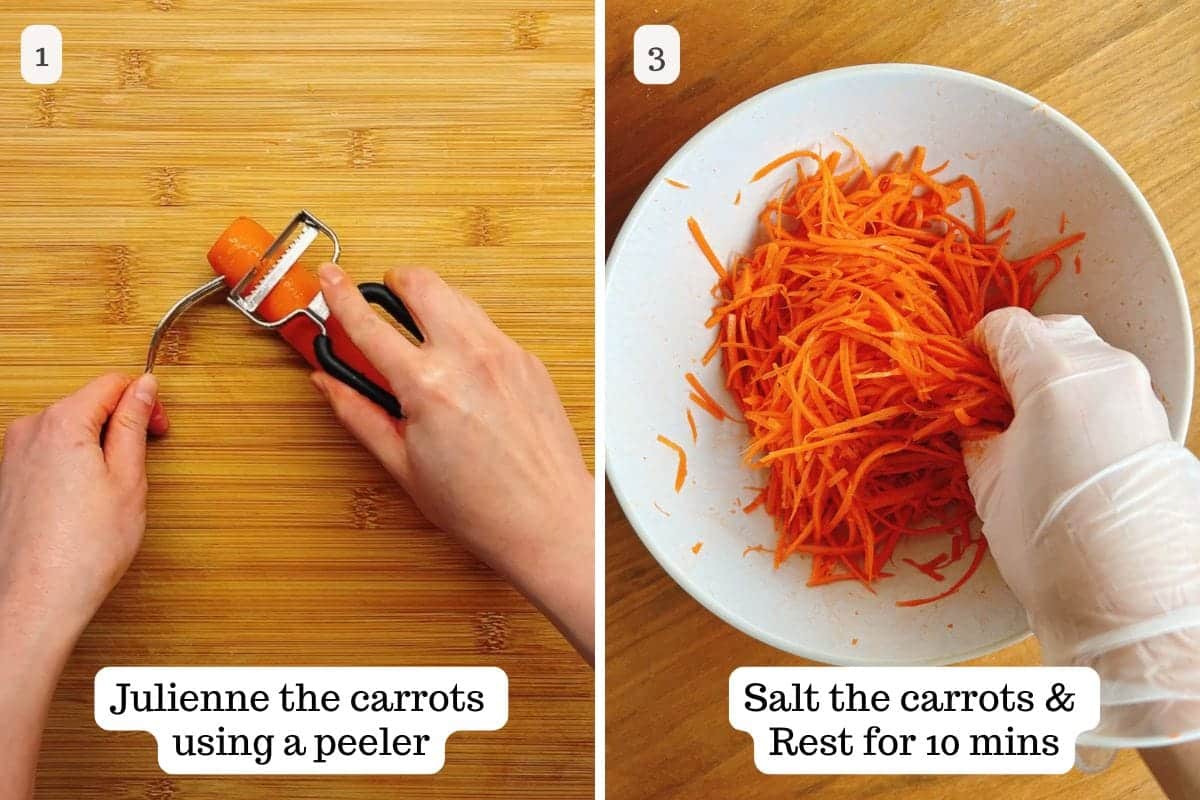
Step 1: Start with good carrots
Trim the ends, give them a good scrub, and dry them off. I use a julienne peeler to make long, thin, noodle-like carrot strands.
Step 2: Here’s my trick for peeling safely
Stick a fork into the thicker end of the carrot to hold it in place, then peel with the other hand. You can tilt the carrot or lay it flat—just rotate as you go to get the most out of it. You should end up with around 7.5 to 8 oz of shaved carrots.
Step 3: Salt them and let them hang out
Toss the carrots with some salt using your hands. Just a quick 30-second mix, then let them sit for 10 minutes. This step helps soften them a bit and pulls out some moisture so the flavor gets in better.
Step 4: Get your aromatics ready

While the carrots are resting, mince the garlic and slice the scallion. Keep the white and green parts separate—we’ll use them differently.
Step 5: Heat the oil until it’s hot enough
Use a small saucepan and heat your neutral oil over medium heat, uncovered. Don’t cover the pan—this traps heat and can actually cause a flare-up when the lid is removed. After about 6–7 minutes, the oil should be shimmering.
Tip: To check if the oil’s ready, dip the end of a wooden chopstick into the pan. If you see little bubbles form around it, you’re good to go. No bubbles? Give it a bit more time. Just don’t let the oil smoke—it’ll burn the aromatics and make them bitter.
Step 6: Pour the hot oil right over the aromatics
Pile the garlic, scallion whites, and gochugaru on top of the carrots. Carefully pour the hot oil over everything—you’ll hear a sizzle right away. This activates the flavor.
Step 7: Season and toss everything together

Add black pepper, sugar, toasted sesame oil, and lemon juice. Use your hands to gently toss everything until it’s well mixed.
Step 8: Serve it now or let it chill in the fridge
You can eat it right away, but I usually like to let it chill for a few hours. The flavor gets even better. To serve, mound the salad up a little for height, top with scallion greens, and sprinkle some sesame seeds.
What to serve it with
This crunchy, tangy viral carrot salad adds a bright pop of flavor to any meal. It’s great for summer and makes a nice contrast to rich or savory mains.
- For protein, try it with juicy Kalbi (Korean short ribs), spicy-sweet Gochujang salmon, or a comforting Bulgogi beef bowl.
- It also works well with rice and noodles—pair it with Vegetarian bibimbap, a Crispy rice bibimbap salad, or a bold and saucy Gochujang pasta.
Try more Korean side dishes next!
If you loved this TikTok carrot salad, here are a few more Korean-inspired veggie sides to keep things fresh and flavorful.
- Korean cucumber salad – Cool, crisp, and just the right amount of spicy.
- Korean zucchini side dish – Lightly stir-fried with garlic and sesame, perfect for banchan.
- Korean cabbage salad – Fresh, crisp, and a little tangy. This shredded green cabbage side dish is super easy to make and delicious!
- Asian carrot slaw – Easy and refreshing summer side dish seasoned with sesame oil and garlic.
Korean carrot salad recipe
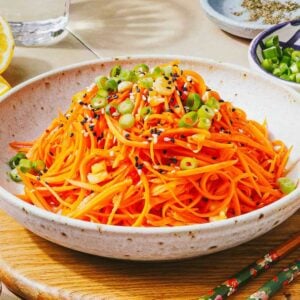
Video
Ingredients
- 12.5 oz carrots about 3 large chubby ones
- ½ tsp coarse sea salt or more to taste
- 0.3 oz garlic finely minced (2 medium or 1 tbsp)
- 1 bulb scallion sliced into small rounds
- 2 tbsp avocado oil or any neutral-flavored oil
- 1 tsp gochugaru Korean red pepper flakes, or more for spicier taste
- Pinch ground black pepper
- 1 tbsp sugar or coconut sugar
- ½ tbsp toasted sesame oil
- 1 tbsp lemon juice or more to taste
- Sprinkle Toasted black and white sesame seeds for garnish
Equipment
Instructions
- Trim the ends of the carrots. Rinse, scrub, and pat them dry. Use a julienne Y-peeler to shave the carrots into long, thin noodle-like strips.
- To do this safely, insert a fork into the thicker end of the carrot. Hold the fork with one hand and peel with the other. You can try either tilting the carrot at an angle or laying it flat against the cutting board. Rotate as you go so you can shave from all sides and get the most out of it. You should get about 7.5 to 8 oz of shredded carrots.
- Place the carrots in a large mixing bowl. Sprinkle with salt and gently toss by hand for about 30 seconds. Let sit for 10 minutes.
- Meanwhile, finely mince the garlic and slice the scallion into small rounds, separating the white and green parts.
- In a heavy bottom small saucepan (uncovered), heat the oil over medium heat until it starts to shimmer, about 6-7 minutes.
- Place the garlic, scallion whites, and gochugaru flakes on top of the carrots. Carefully pour the hot oil directly over the aromatics to release their flavor.
- Season with black pepper, sugar, sesame oil, and lemon juice. Gently toss by hand until everything is well combined.
- To serve, shape the carrots into a small mound with a little height. Add scallion greens on top and sprinkle with sesame seeds.
- You can serve it right away, or chill for a few hours to let the flavors meld. Keep well in the fridge for up to 5 days.
Notes
- Carrot selection: I found that chubbier, shorter carrots are easier to julienne with a julienne peeler. Choose fresh, plump, juicy ones with bright orange skin and a firm, crisp texture so the shaved carrots taste their freshest and sweetest.
- Acidity substitute: Lemon juice brightens the salad and gives it a refreshing lift. You can also use rice vinegar instead. Avoid darker vinegars like balsamic—it’ll change the color of the carrots after marinating.
- Tools: If you don’t have a julienne peeler, you can also use a vegetable spiralizer or use a Y-peeler to shave the carrots into ribbons. Just keep in mind—the wider and thicker the carrot slices, the longer they’ll need to marinate for the flavor to fully come through.
- Gochugaru substitute: If you don’t have gochugaru, substitute with a touch of cayenne pepper and paprika.
Nutrition
Nutrition information is automatically calculated, so should only be used as an approximation.
Made a dish and loved it? Please rate the recipe and leave a comment in the section below! It helps my blog grow organically, allowing me to continue sharing free and awesome content with you. Thank you!
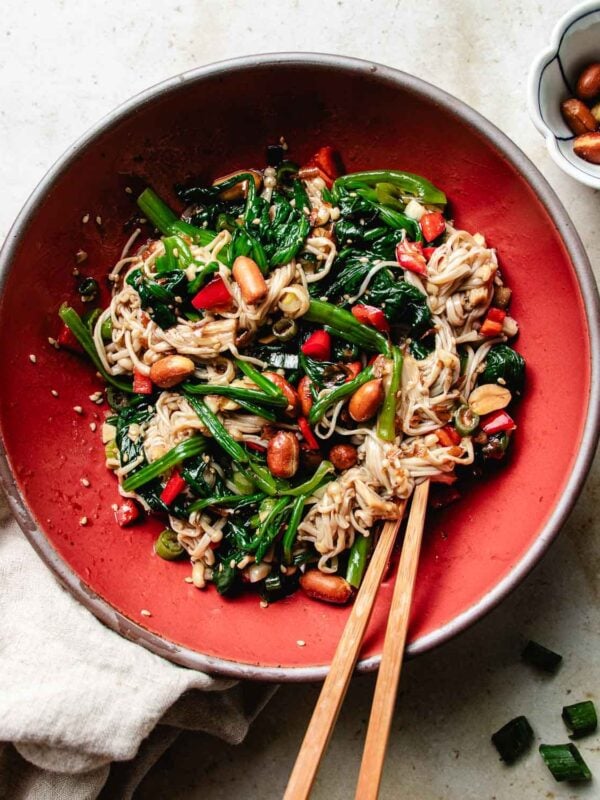
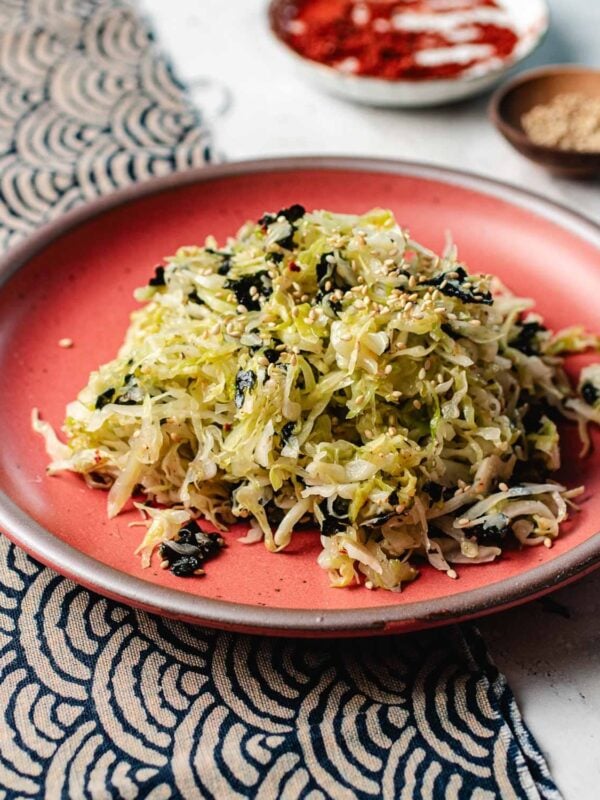
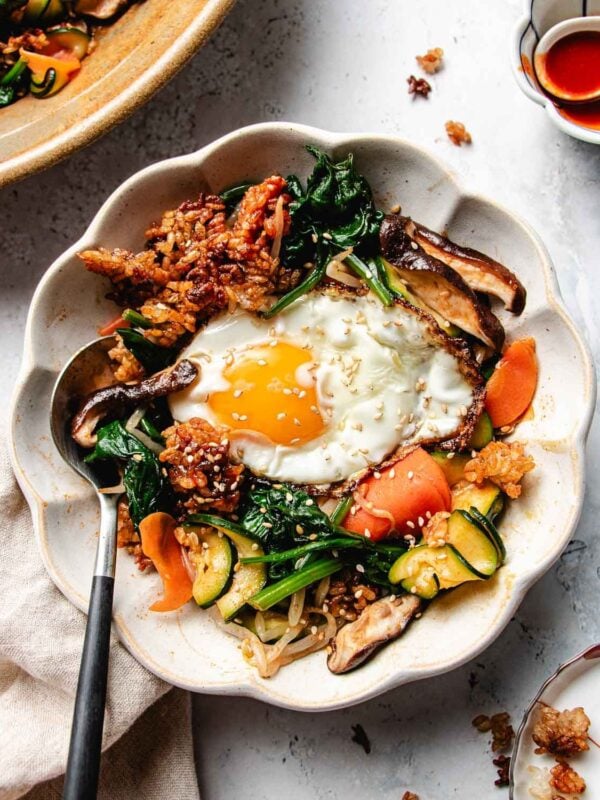
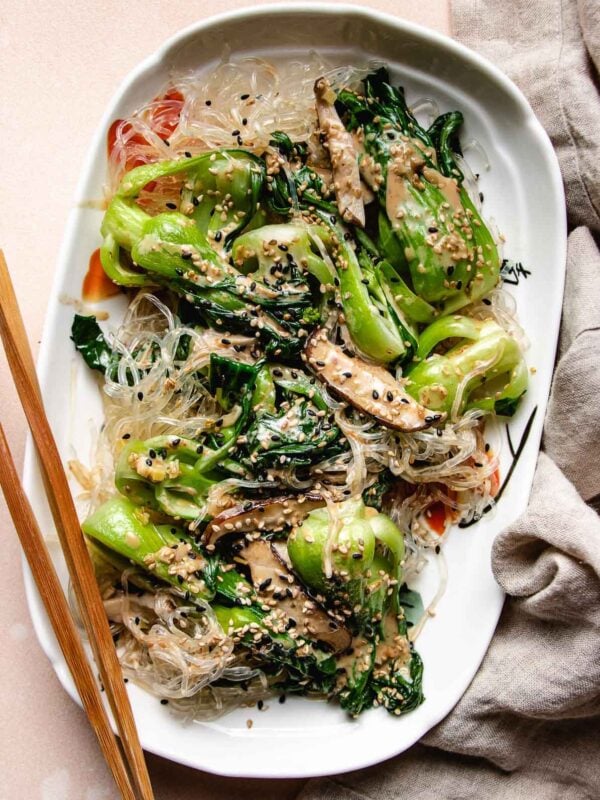
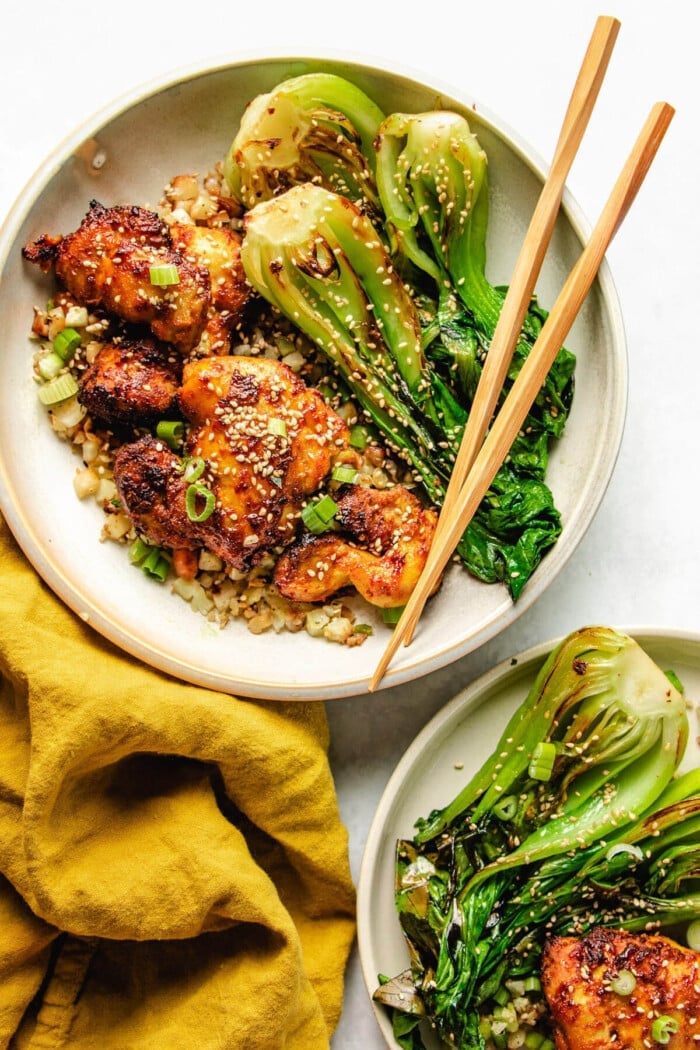








Delicious!!! Took me awhile to julienne the carrots but everything came together easily. Would like it to be spicier so will try using cayenne pepper next time. Will be making this again!
Lovely! You can also shaved it into wide ribbons so that might be faster. :))